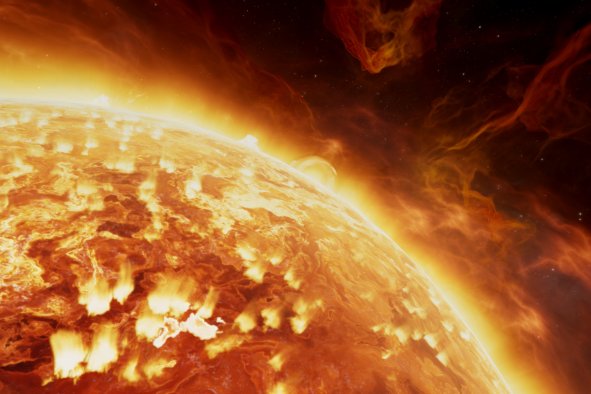The nation's capital may be one of the most at-risk cities from the effects of intense solar storms.
Washington, D.C., and Milwaukee, Wisconsin, have been identified by scientists as having power grids that are especially vulnerable to geomagnetic storms, researchers recently revealed at the Royal Astronomical Society's National Astronomy Meeting in the United Kingdom.
This means that these cities could be severely impacted by powerful solar weather, including solar flares and coronal mass ejections, leading to power outages and more.
"We have identified certain regions of the US (Washington DC area and Milwaukee) which are repeatedly appearing as 'highly connected' in our network, and hence, are possibly regions particularly vulnerable to the effects of space weather and may benefit from further monitoring," Lauren Orr, a researcher at the British Geological Survey (BGS), said in a statement.
Active regions like sunspots on the surface of the sun can suddenly explode, spending out flashes of radiation in the form of solar flares and huge bursts of solar plasma known as coronal mass ejections (CMEs). If a CME is directed toward the Earth, it can collide with our planet's magnetic field and trigger a geomagnetic storm.
"A geomagnetic storm is essentially caused by the interaction of a disturbance in the solar wind and the Earth's magnetosphere-ionosphere system. Significant disturbances in the solar wind can be caused by coronal mass ejections," Brett Carter, an associate professor in space science at RMIT University in Australia, told Newsweek.
The changing magnetic fields during a geomagnetic storm induce electric fields on the Earth's surface through a process known as electromagnetic induction. These induced electric fields can cause currents to flow through any conductive materials present on the Earth's surface, including power lines, pipelines, and railways.
These currents are known as geomagnetically induced currents (GICs) and can damage transformers, unstabilize the voltage of the power grid, and cause power outages.
"Pipelines, high frequency (HF) radio/radar and satellites in orbit are significant affected by [powerful] storms," Carter said. "Pipelines are known to also carry geomagnetically induced currents, which accelerates their corrosion. Satellites can experience increased surface charging due to the plasma environment in orbit, and this can affect the onboard electronics and operation of the satellite."
According to the new research presented by the scientists—which has not yet been published in a peer-reviewed journal—Milwaukee and D.C. are most at risk from these impacts for reasons including "the electrical conductivity of the ground, the physical construction of the power grid in those areas, or the location of the auroral currents in the sky," Orr said.
Orr said this makes the cities so-called "supernodes" in the power network, but more research is needed to determine precisely why they are so vulnerable to space weather.
However, she cautioned that further work was needed to investigate what makes these areas so-called "supernodes" in the network.
The researchers hope that locating points of weakness in the electrical grid could help us protect against future geomagnetic storms hitting the Earth.
"By applying known reliability parameters to the GIC network we can identify areas or transformers at high risk," Orr said. "These areas could be modified during a geomagnetic storm to prevent transformers burning out and to limit damage to the wider power grid."
Do you have a tip on a science story that Newsweek should be covering? Do you have a question about geomagnetic storms? Let us know via science@newsweek.com.
Disclaimer: The copyright of this article belongs to the original author. Reposting this article is solely for the purpose of information dissemination and does not constitute any investment advice. If there is any infringement, please contact us immediately. We will make corrections or deletions as necessary. Thank you.




